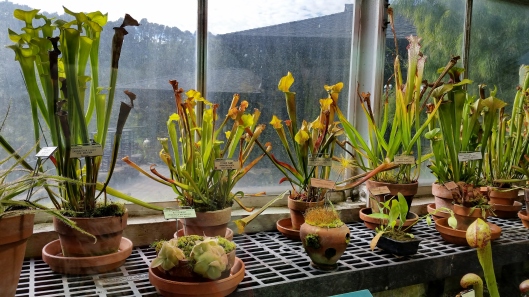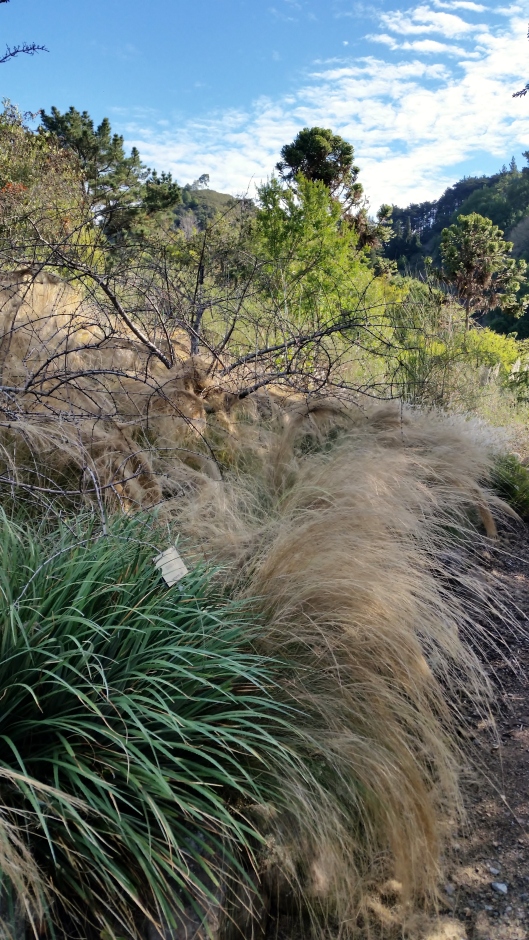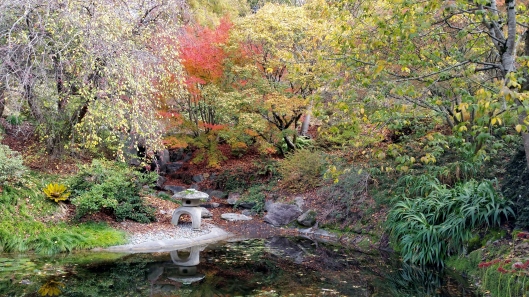Tags
Arid House & Xerophytic Fern Display, Bromeliad Deuterocohnia brevifolia, Coastal Redwood, Cultivating Carnivorous Plants, Eryngium sp. 'La Canada', Fog Desert, Gather restaurant Berkeley, Madagascar Palm, Pachypodium lamerei, Sequoia sempervirens, Strawberry Canyon, The Savage Garden, Tips for a Waterwise Garden, University of California Botanical Garden at Berkeley
 We are back from our week in California. Our vacations are always part working vacations. We enjoy touring nurseries and gardens to learn more about plants in other parts of the country or world. Our first stop on this trip was the University of California Botanical Garden at Berkeley. The weather was perfect in the high sixties and the day was very clear, especially for the bay area. This garden is laid out with different areas recreating habitats from around the world. It is one of the most diverse in the country. It is located in Strawberry Canyon which makes a beautiful backdrop from every vantage point. It is a living museum and working botanical garden with ongoing research.
We are back from our week in California. Our vacations are always part working vacations. We enjoy touring nurseries and gardens to learn more about plants in other parts of the country or world. Our first stop on this trip was the University of California Botanical Garden at Berkeley. The weather was perfect in the high sixties and the day was very clear, especially for the bay area. This garden is laid out with different areas recreating habitats from around the world. It is one of the most diverse in the country. It is located in Strawberry Canyon which makes a beautiful backdrop from every vantage point. It is a living museum and working botanical garden with ongoing research.
First we headed to the hot houses that were directly in front of us. 
Arid House & Xerophytic Fern Display.
There were signs everywhere with a wealth of information.
 Tips for a Waterwise Garden:
Tips for a Waterwise Garden:
• Choose plants that are appropriate to the micro-climate.
• Group plants into zones by their water needs.
• Plant in fall and winter to establish plants during the rainy season.
• Use mulch, woodchips, compost, and gravel to retain moisture in the soil.
• Irrigate carefully. Check that water is going into the ground and not onto pavement.
• Remove weeds that compete for water.
• Grown thirsty plants in containers.
The label said Pachypodium lamerei; I have one at home but it is not as unusual looking at this one. It does have large thorns and leaves mostly just at the top of the plant. Pachypodium lamerei is a stem succulent native to the island Madagascar. They can flower with very fragrant large flowers. It is easy to grow and has become popular, known as a “Madagascar Palm” because it looks palm-like, however it is not related to palms. I have several fun plants from Madagascar. I think I will have to put it on my list of places I would like to visit!
I could have stayed an hour just in this House alone. Lithops: also known as flowering stones or living stones. And they do look much like stones and this is part of their protection from grazing animals that would eat them when little water is available. They are native to drier regions of the southern part of Africa where rain fall can be limited. They are able to survive on fog alone during times of drought. Its ability to store water is how it survives. Everything about its design is conducive to collecting and storing water. The leaves fuse together to create a basin. The roots connect to the leaves without a stem minimizing the need for water. Their small size minimizes the effect of the heat of the desert and the stout leaves are able to store enough water for the plant to survive for months without rain. Their small size minimizes the effect of the intense heat and light of their climate.
We learned what a Fog Desert is from one of the information plaques. I had not heard of a Fog Desert but I do know from growing up in Southern California that many of the coastal plants depend on the fog for moisture. Fog deserts are a rare coastal variant of true arid deserts. Fog deserts arise from the combination of cold ocean currents alongside a hot, dry land mass. The hot interior draws a steady drift of clouds and fog across the otherwise dry land. As a result, when the fog is in, the temperatures remain cool. Without the presence of fog, temperatures can skyrocket. Though average yearly rainfall in a fog desert can range from absolutely nothing to 2 inches, the additional moisture from fog can support a rich array of unusual succulent’s plants. Two of the world’s fog deserts occur on the Pacific coast: the Baja California Desert of California and Mexico and The Atacama Desert of coastal Chile and Peru.
 From the hot house we headed out to the desert of the America’s. Here I saw many plants I am familiar with growing up in the southwestern United States. And a few I would love to grow. I do miss the arid climate of California.
From the hot house we headed out to the desert of the America’s. Here I saw many plants I am familiar with growing up in the southwestern United States. And a few I would love to grow. I do miss the arid climate of California.

The cactus apples looks so beautiful and I loved the Bromeliad
Deuterocohnia brevifolia. It is now on my plant lust list!
After the desert we backtracked a little to see another hot house. That is filled with more of my favorite plants. We have a fern garden here at Ravenscourt and I grow a few orchids in the house. And this summer I strayed into collecting carnivorous plants. I found a book in the book store called The Savage Garden, Cultivating Carnivorous Plants and another called Growing Carnivorous Plants. It is fascinating this world of plants! I hope to get more, like these below.
That is filled with more of my favorite plants. We have a fern garden here at Ravenscourt and I grow a few orchids in the house. And this summer I strayed into collecting carnivorous plants. I found a book in the book store called The Savage Garden, Cultivating Carnivorous Plants and another called Growing Carnivorous Plants. It is fascinating this world of plants! I hope to get more, like these below. Next we headed through some coastal redwood trees to the Chinese Medicinal Herb Garden. Across from the parking lot you can visit the Mather Redwood Grove with Winter creek flowing through it.
Next we headed through some coastal redwood trees to the Chinese Medicinal Herb Garden. Across from the parking lot you can visit the Mather Redwood Grove with Winter creek flowing through it.
The garden is open everyday from 9am-5pm except on major holidays. We learned that California has a greater biotic diversity than any other state. And is one of the 25 biodiversity hotspots that contains 44% of the world’s plant species. Conservation is one of the important missions of the U.C. Botanical garden and it participates with the Center for Plant Conservation and Botanic Gardens Conservation International. They gardens are also used for national and international research and it provides plant materials to scientists in many fields.
 The emphasis is on plants that grow in Mediterranean climate. With hot houses for collections of more climate-dependent plants. As we walk through the garden we found ourselves in different regions with plants from that geographic location arranged together. The wonderful thing is they are all doing just fine in Berkeley California with its zone 9b Mediterranean climate.
The emphasis is on plants that grow in Mediterranean climate. With hot houses for collections of more climate-dependent plants. As we walk through the garden we found ourselves in different regions with plants from that geographic location arranged together. The wonderful thing is they are all doing just fine in Berkeley California with its zone 9b Mediterranean climate.
They offer programs for the public that sound very interesting and various guided tours can be arranged if you call in advance. We were happy to go at our own pace. Stopping to take pictures of plants and labels of plants we wanted to look up later. There were plenty of plants in bloom which was a treat.
This was a garden where I was so please that there were labels and plaques full of information.
It was not possible to take this all in and I am enjoying going back and picking a few photos to share with you. When I was in Portland last summer I saw an Eryngium planum Blue Hobbit that I want to try to grow in Houston. When we came across this plant I recognized the name. I would love to have seen it in bloom. I was fascinated by the thistle like seed pods on this one. The label said Eryngium sp. ‘La Canada’ (Eryngium) from Queretaro State, Mexico. Queretaro is a town of La Canada at 8,120′ elevation. According to Plant Delight Nursery it is still an unidentified eryngium. It grows in clumping form and in summer it gets 2 foot spikes with small green flowers. From the Mexico and Central America section you can get stunning views of the top of the ridge. In the foreground are several silver blue Martinez Pinyon Pines.
 Next we headed to South America which reminded me a lot of Southern California foothills. On the side of the path we came across several grasses. The one with plumes below reminded me of Mexican Feather grass but the leaves looked more like a muhly.
Next we headed to South America which reminded me a lot of Southern California foothills. On the side of the path we came across several grasses. The one with plumes below reminded me of Mexican Feather grass but the leaves looked more like a muhly.

Jarava plumosa, common names jarava, plumerillo, South American rice grass. It is native to South America (i.e. southern Brazil, Argentina, Bolivia, Chile, Uruguay and Peru). It is considered an invasive weed in Australia where it was introduced as a pasture plant in the early 1940’s.
 Around the corner just as we were leaving South America we saw this beautiful tall green plant will bright yellow blooms. It is a Darwin Barberry, Darwin’s Berberis, Berberis darwinii from Chili. I like barberry and have a couple in my garden. I wonder if this variety would thrive here? I read up on it and it is zone 8b – 7a, I have several plants that are 8b even though the Heights is 9a.
Around the corner just as we were leaving South America we saw this beautiful tall green plant will bright yellow blooms. It is a Darwin Barberry, Darwin’s Berberis, Berberis darwinii from Chili. I like barberry and have a couple in my garden. I wonder if this variety would thrive here? I read up on it and it is zone 8b – 7a, I have several plants that are 8b even though the Heights is 9a.
We walked through the cross roads to Australasia on the left and Mediterranean on the right. Those will have to keep for another visit. We cut through Asia to view the Japanese Pool.
 The Japanese Pool was constructed from the Japanese exhibit at the 1939 International Exposition on Treasure Island which you can get to from the Bay Bridge. The pond is surrounded by Japanese Maples, and a variety of Rhododendrons. The Rhododendron arboreum (Tree Rhododendron) from the Himalayas is one of the earliest bloomers in the garden each year. There are other shrubs including some from the witch hazel family, hydrangeas and epinmediums.
The Japanese Pool was constructed from the Japanese exhibit at the 1939 International Exposition on Treasure Island which you can get to from the Bay Bridge. The pond is surrounded by Japanese Maples, and a variety of Rhododendrons. The Rhododendron arboreum (Tree Rhododendron) from the Himalayas is one of the earliest bloomers in the garden each year. There are other shrubs including some from the witch hazel family, hydrangeas and epinmediums.
 The topography of the area in the foot hills of Berkeley accommodates the diverse native habitats of Asia. It is Sunny, relatively dry around the perimeter with the middle surrounding the stream and pond becoming damp and shaded which is often 10 degrees cooler as it dips deeper in to the canyon. The collection includes Dawn redwoods, Metasequoia glyptostroboides, once thought to be extinct but rediscovered in western China in 1944. These are among the first grown outside of China.
The topography of the area in the foot hills of Berkeley accommodates the diverse native habitats of Asia. It is Sunny, relatively dry around the perimeter with the middle surrounding the stream and pond becoming damp and shaded which is often 10 degrees cooler as it dips deeper in to the canyon. The collection includes Dawn redwoods, Metasequoia glyptostroboides, once thought to be extinct but rediscovered in western China in 1944. These are among the first grown outside of China.
This has been a long post thank you for taking the tour. I hope we have piqued your interest. There was so much more I could have shared and so much we didn’t see ourselves. We will definitely be back! Thankfully Southwest has a direct flight to Oakland from Houston. We found a fabulous restaurant for a late lunch called Gather…with locally sourced organic food. The perfect end to our day!
Happy Gardening from Laurin and Shawn.












This is wonderfully photographed. Thanks many.
LikeLike
You are most welcome! Wish I could have made this into many post. Such a fascinating place.
LikeLike
Very good tour, and I’ve only passed the Berleley exits on the freeway…next time, whenever that may be. Blue Pinyon pines? Yowza…so much to learn or even find and try!
LikeLike
Next time take the off ramp! It is a really great botanical garden, with most plants growing in the ground. And Berkeley has a few cool nurseries too…and many good eats!
LikeLike
We were just there in September (our second visit, the first in 2009) and I took hundreds of photos, it’s such a fabulous place. Glad you guys were able to visit and enjoyed it!
LikeLike
I thought of you Loree when I saw all the cool dangerous plants : )
LikeLike
I made it to Berkeley after the San Francisco Fling, but only to Marcia Donahue’s garden and Chez Panisse. No complaints there! But I wish I could have seen this garden too.
LikeLike
I hope you find yourself back there someday! I can’t wait to go again : )
LikeLike
Pingback: Weeds of North America – Book Recommendation | Ravenscourt Gardens
Fog Desert – I always thought of the coast of San Diego and LA as that, but a coworker from the midwest asked me why it’s still more green. That got me looking more, and reasearching…close, but still not dry enough to be arid desert like parts of Chile, S. Africa, etc. Quite a specialized way that plants grow…condensation, where there’s little precipitation. Fun tour, again. Those scenes look like they are often taken in a remote canyon somewhere!
Too bad when you land, it’s Oakland’s airport, and not SJ or SF.
LikeLiked by 1 person
We chose to fly into Oakland because it is a direct flight from Houston : ) And we found a great place to stay right on the water at the Oakland Embarcadero. I feel in love with Berkeley when I used to live in Northern CA. And you are right SD is not a fog dessert but the fog does play a big roll in keeping the plants alive.
LikeLike
Pingback: 5 Best Pollution Tolerant Plants for Smoggy Urban Gardens